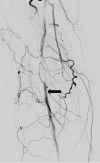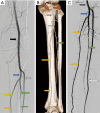Lower extremity arteries
- PMID: 31559162
- PMCID: PMC6732106
- DOI: 10.21037/cdt.2019.07.08
Lower extremity arteries
Abstract
Lower extremity arteries play vital role of supplying blood to the extremity bone, muscles, tendons and nerves to maintain the mobility of the body. These arteries may get involved with a number of disease processes which restrict the optimal functioning of the limb. The knowledge of various diseases, clinical presentation, appearance on various imaging modalities and segments of involvement helps one to clinch the diagnosis. It is of paramount importance for imaging clinician to apply the correct imaging tool based on the clinical question which is facilitated by know how of the advantages and limitation of each of these imaging modalities. This article focuses on lower extremity arteries, its anatomy, various imaging modalities and common disease conditions affecting the lower limb arteries.
Keywords: Lower extremity arteries; computerized tomography; digital subtraction angiography; doppler; magnetic resonance imaging; ultrasound.
Conflict of interest statement
Conflicts of Interest: The authors have no conflicts of interest to declare.
Figures










References
-
- Butler P, Mitchell AWM, Ellis H, Healy JC. Applied radiological anatomy. Cambridge University Press; 2012:400.
-
- Bajzer Christopher T. Arterial supply of the lower extremities - Guide to Peripheral and Cerebrovascular Intervention - NCBI Bookshelf. Remedica Pub, 2004:291.
-
- Scheinert D, Werner M, Scheinert S, et al. Treatment of Complex Atherosclerotic Popliteal Artery Disease With a New Self-Expanding Interwoven Nitinol Stent: 12-Month Results of the Leipzig SUPERA Popliteal Artery Stent Registry. JACC Cardiovasc Interv 2013;6:65-71. 10.1016/j.jcin.2012.09.011 - DOI - PubMed
-
- Koshy CG, Chacko BR, Nidugala Keshava S, et al. Diagnostic accuracy of color Doppler imaging in the evaluation of peripheral arterial disease as compared To digital subtraction angiography. Vasc Dis Manag 2009;6:2-9.
Publication types
LinkOut - more resources
Full Text Sources
